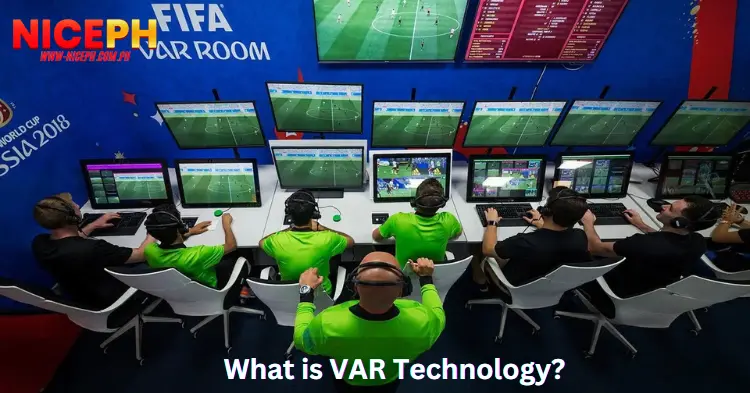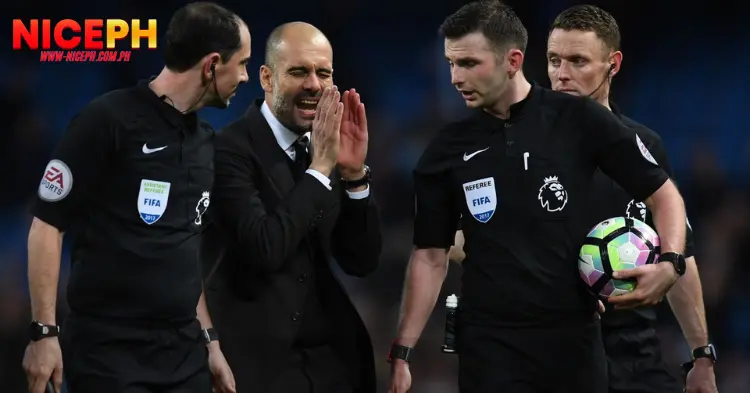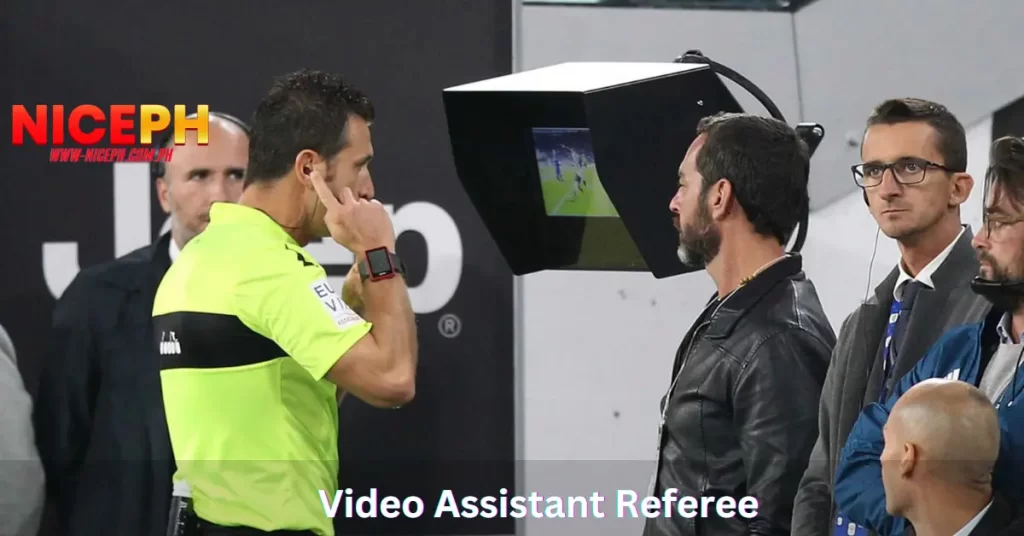Technology has become indispensable in football over the last few years. One of the most popularly used innovations goes by the name VAR, or “Video Assistant Referee“. With the help of VAR, referees are able to review disputed situations in matches for more accurate decisions, thereby reducing errors and increasing fairness.
But what exactly is VAR? How does it work? What are its advantages and limitations? In this comprehensive article with NicePH, let’s dive into everything about VAR technology in football.
What is VAR Technology?
VAR (Video Assistant Referee) is a technology that uses video assistance to support referees. It is widely implemented in major football tournaments to aid referees in making the most accurate decisions, thereby minimizing controversial situations.
VAR is regarded as a revolutionary innovation that has transformed the world of football. Through slow-motion video analysis, VAR allows referees to examine every detail of a situation and make impartial decisions.

VAR involves a team of professional referees who review contentious incidents from multiple angles using cameras strategically placed around the stadium. This team provides the on-field referee with relevant information to help them make more informed decisions.
The number of cameras in a VAR system varies depending on the infrastructure of each competition. A minimum of 33 cameras is required, including four Ultra Slow Motion cameras (capturing at 120 frames per second) and eight Super Slow Motion cameras.
Other cameras must meet Ultra HD resolution standards to deliver the clearest images possible. These 33 cameras operate continuously, covering all angles of the field, especially critical areas like the goalposts and sidelines, which are monitored by specialized cameras.
VAR technology not only represents a significant innovation in football but also provides referees with a cutting-edge tool to analyze every situation in detail. With VAR, referees can assess situations thoroughly and make the fairest decisions.
VAR has been employed in major tournaments such as the FIFA World Cup and UEFA Champions League, significantly reducing the number of incorrect referee decisions during matches.
When is VAR Technology Used?
VAR is not automatically employed in every situation; it only intervenes in specific scenarios determined by FIFA. These scenarios include decisions regarding goals, penalty awards, and direct red card offenses, ensuring referees on the field are supported in making fair and transparent decisions.
Controversial Goal Situations

VAR plays a crucial role in reviewing contentious goal situations raised by opposing teams. It enables referees to reexamine the entire sequence leading to a goal. Minor infractions such as offside or handball often unnoticed from the on-field referee’s perspective—are captured by VAR cameras and relayed to the referee. The referee then carefully evaluates the situation and makes the most accurate decision to ensure fairness and transparency in the match.
Penalty Situations
VAR is frequently used in determining penalties during football matches. Referees often rely on VAR in sensitive situations to make precise decisions. This helps minimize conflicts and disputes among players and fans from both teams, ensuring a fair and transparent game.
Direct Red Card Offenses
Violent conduct in football can have severe consequences, not only impacting players’ physical and mental health but also inciting anger among fans. This is why VAR was developed—to minimize the worst incidents and ensure fair decision-making.
In addition to addressing controversial situations, VAR also clearly outlines its scope of intervention in direct red card incidents. VAR only intervenes when a referee decides to issue a direct red card, while second yellow card situations are not supported by this advanced technology. This ensures the focus remains on the most critical scenarios, maintaining fairness and transparency in referees’ decisions.
=> Read more: Al Rihla – The Most Unique Ball in History
Incorrect Referee Decisions
Referees often face criticism for incorrect decisions on the field. This is where VAR comes in, reducing errors and giving referees the opportunity to correct or adjust their calls, leading to a fairer game.

While VAR offers numerous advantages, it is not without its criticisms. Matches officiated with VAR are generally more equitable, but some argue that it diminishes the emotional aspect of football. Additionally, the time referees spend reviewing footage on the sidelines can prolong the game and reduce its excitement. Nevertheless, the acceptance of VAR technology is growing, with many seeing it as a progressive step towards greater fairness in football.
The Benefits of VAR Technology in Football
- Ensuring Fairness: VAR enables referees to review disputed situations and make more accurate decisions, ensuring fairness for both teams.
- Minimizing Errors: VAR helps reduce referee errors in critical situations such as penalties or goals, leading to fairer matches and improved referee performance.
- Increasing Competitiveness: By minimizing referee mistakes, VAR enhances the competitiveness and aesthetic value of football. Greater fairness and accuracy make the game more engaging, particularly in major tournaments.
- Promoting Professionalism: Utilizing VAR brings a higher level of professionalism to football, as accurate decisions boost trust among teams and fans. This also elevates the quality of matches and the reputation of the sport.
However, VAR does face challenges, such as slowing down the game’s pace when referees review controversial situations multiple times.
=> Read more: Who Are the 10 Tallest Football Players in the World?
How the VAR System Operates
Structure and Components of the VAR System

The VAR system comprises several main components:
- Cameras: Positioned around the pitch to capture contentious moments during a match.
- Video Analysis Stations: Located strategically to collect data from cameras.
- VAR Control Room: Where specially trained referees review incidents and provide decisions.
- Communication Devices: Tools like radios or computers facilitate communication between on-field referees and the VAR control room.
- On-Pitch Screens: Used by on-field referees to review contentious moments and finalize decisions provided by VAR.
These elements work together to create a fully operational VAR system, enabling referees to make accurate and fair decisions in disputed situations.
VAR Workflow During Matches
The typical VAR process in a match involves these steps:
- When a controversial situation arises, the on-field referee signals for VAR assistance by drawing a rectangle to indicate the area in question.
- VAR reviews the footage from various camera angles to provide the most accurate assessment.
- If necessary, VAR referees request additional angles or information to clarify the situation.
- After analyzing the footage, VAR provides a final decision to the on-field referee through communication devices.
- The on-field referee may confirm or modify their decision based on VAR input.
- The final decision is announced to the teams and spectators via on-pitch screens.
The specifics of this workflow may vary depending on tournament rules and football association policies, but this general process ensures VAR effectively supports referees in resolving disputed incidents.
Issues and Controversies Surrounding VAR Technology
While VAR improves fairness and accuracy, its implementation has sparked debates and revealed challenges.
One major controversy is the time taken to process disputed situations. Referees pause the game to review footage, which disrupts the match flow and may affect players’ momentum.
Additionally, technical challenges, such as determining offside positions or identifying ambiguous fouls, can still lead to contentious decisions despite VAR usage.
From a moral perspective, some critics argue that VAR diminishes the suspense and emotion of football. Others note that even with VAR, decisions may only sometimes be entirely accurate or fair.
=> Are you looking for a reputable and top-quality casino for betting? Try our partners: Phwin.
Conclusion of VAR Technology
VAR represents a groundbreaking technological advancement in football, enhancing fairness and improving referee decision-making. Despite its benefits, the system faces challenges and criticisms, underscoring the need for continuous research and development. As VAR evolves, we can look forward to a future where football becomes an even more precise and equitable sport.

